1. Introduction
At the end of the last century’s 80s a small group of senior executives working for various insurers, including the
Consorcio de Compensación de Seguros, decided to create a shared research centre with the intention of finding out more about motor vehicles. This was how the
Instituto de Investigación sobre Reparación de Vehículos, S.A. (the Vehicle Repairs Research Institute) came into being, the trade name of which,
Centro Zaragoza (Zaragoza Centre in English), is attributable to the fact that the urban centre of Pedrola was chosen for its location, which lies some 35 kilometres from the capital of Aragon, Zaragoza, for the facilities housing it to be constructed.
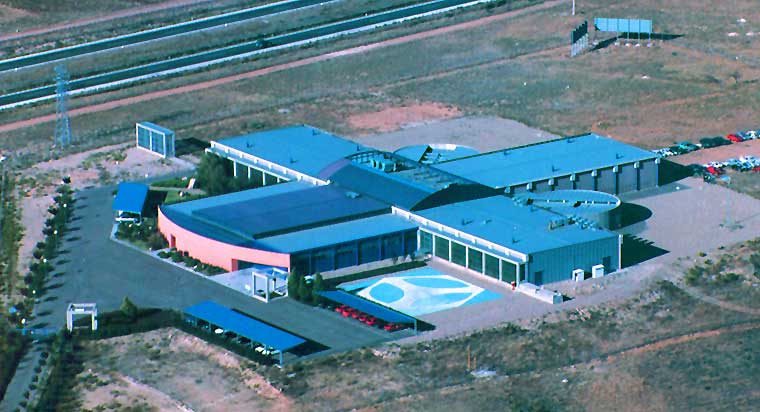
Figure 1. Bird’s eye view of the Centro Zaragoza facility.
The company was set up in 1987 and its founders were (as has been mentioned) a group of insurers — 14 to be precise. A couple of years later the Centro Zaragoza facility opened its doors with a small group of professionals who were experienced in repairing vehicles as well in the audio-visual world, for, from its very beginnings the centre always felt the need to disseminate the findings from the research it carried out. It is therefore not by mere chance that the first “product” which the fledgling research institute came up with was a course that targeted motor insurance adjusters, who were more commonly known at that time as “average adjusters”. Specifically this was a refresher course for expert knowledge because a vast degree of disparity had been noted at that time among the professionals who provided technical advisory services to the insurance sector, on account of both their very different professional backgrounds and academic training and the dissimilitude of the techniques and materials applied in vehicle repair workshops. It should be recalled that in those days there was no ready reckoner that made it possible to calculate repair times, for which reason the valuation for each repair became a distinct negotiating process between the adjuster and the workshop based on each party’s previous experience which gave rise to great uncertainty among insurers who also noticed a considerable cost disparity in different geographical areas.
As its required objectives had established when it was founded, Centro Zaragoza’s lines of research were oriented toward studying more effective techniques and methods that could be applied to repairing vehicles. In this regard they began to experiment, for example, with the options for repairing not just the steel panels that motor vehicle bodywork was made of, but also their windscreen glass or the plastic materials that are often used in the car industry. All of this, which might seem rather obvious to us nowadays, prompted quite a bit of resistance to such change, chiefly because of the initial lack of know-how in certain sectors associated with the world of repairs in Spain. Suitable information and numerous training days laid on by the professional staff working at Centro Zaragoza were successful in gaining acceptance of the job processes that such repairs called for, which are embraced these days without any arguing at all over whether they are appropriate. This kind of policy can also be extrapolated to a whole raft of examples.
With the passing of time several projects and lines of research were undertaken, passing on valuable knowledge to the motor vehicle sector while at the same time adding new products and services to be offered to insurers, which in turn provided a source of funding for the Centro Zaragoza that complemented the contributions from the owner organisations that gave backing for the centre. Years later, mindful of the broad range of activities that the institute was engaged in, the word “Reparación” (Repairs) was removed from its name and it came to be called the “Instituto de Investigación sobre Vehículos, S.A.” (the Vehicle Research Institute, in English).
2. Projects carried out by the centre
The activities pursued by
Centro Zaragoza from 1997 became more intensive, which in turn meant enlarging its team of full-time staff considerably. The work by the various teams, departments and functional areas at the centre made it possible to create an ample catalogue of services aimed at helping the sector out with handling property damage and preventing bodily injury through fomenting initiatives that sought to improve road safety.
Ten years later, in 2007,
Centro Zaragoza had finally managed to become self-financing. In practice what this meant was that, for the first time in its history, the products and services it marketed succeeded in bringing in enough revenue for it to be able to pay for all its outgoings without the regular contributions from its owner institutions, which had been steadily cutting back on their financial support in the previous ten years until this ran out. For the sake of offering an accurate picture of the more developed and established activities (given that some areas of research failed to bear fruit or their results did not end up producing any practical application for the sector) below we provide a description of the catalogue of activities that
Centro Zaragoza currently offers, these being grouped according to the insurance sectors which they serve.
2.1. Services that relate to the area of taking out or underwriting insurance
2.1.1. SIETE database
The acronym SIETE stands for “Sistema Informativo de Especificaciones Técnicas” (Technical Specifications Reporting System in English). This is a database wherein all of the vehicles sold in the Spanish market and which are liable for insurance can be identified. For each record the key technical data is gathered as well as the characteristics to be taken into account in rating. The database is updated on a daily basis and the institutions can download it from the web. This has become standard in Spain’s market and encompasses three classes of motor vehicle, namely private cars and derivatives of these, industrial vehicles and motorcycles. It is used by the vast majority of insurers operating in Spain in the motor vehicles insurance class.
At the moment the use of insurance aggregators that interact directly with the insurance system of insurers to work out premiums is widespread. Vehicles are actually identified using the BASE SIETE code.
Before using this database each insurer would have a team of staff who used to create and keep their own database using specialist magazines or other sources, which just goes to show the progress that has been made, both in unifying codes and modernising cost control and cutting.
Base SIETE represents a distinctive feature of the Spanish market as there are very few other countries in Europe that have anything similar.
2.1.2. CZIDConnect
CZIDConnect is an identification service for technical and administrative features of motor vehicles based on their number plates. The first stage of identification is to obtain their VIN (vehicle ID number, or número de identificación del vehículo) and to do this you send the registration number being queried to the servers at the DGT (Directorate General for Traffic, or Dirección General de Tráfico), whereupon they reply with the relevant VIN for the number plate. Using the VIN you can find out a whole range of technical and administrative information on the specific vehicle. Such data is in itself useful for insurance purposes, but also, thanks to the mapping of the data bases of the technological partners of the Centro Zaragoza with their “Base SIETE” database which brings up matches of car makes and models from both databases, and using this in conjunction with the technical data for each vehicle, it is possible to automatically find the Base SIETE code that corresponds with the vehicle being queried.
The system is designed to perform this entire process on-line and so it can be adapted to the process for taking out policies with insurers. You can also perform queries of this kind in off-line processes for a large number of vehicles if a rapid response is called for, i.e. should it become necessary to review all or part of an insurer’s portfolio.
A further use for this product is to sign up for reports on any change in the administrative data that might arise regarding a specific vehicle. Under this option, the company that has contracted this service for a specific VIN will receive a message telling of the changer that has taken place in administrative information at the time when this is officially effected. This CZIDConnect module is known as “Alerts”.
Finally a reporting system with vehicle manufacturers has been developed whereby you can learn the fittings and features any specific unit left the factory with, as well as how much these cost, which is all of great value when it comes to working out how much the policy is to cost, above all in the case of Premium vehicles, where the cost of the extras is becoming increasingly substantial. This product is called “CZIDConnect Premium”.
2.1.3. CZ Report
This is an on-line vehicle verification system the purpose of which is to provide each insurer with a quick technical report in connection with vehicle verification prior to the insurance policy being taken out.
CZ Report is available via the
Centro Zaragoza website at
www.centro-zaragoza.com, which speeds up the work process without any need for installations or downloads beforehand, representing a tangible advantage for users.
2.2. Services relating to the area of property damage
2.2.1. CZ certification
a) Certification of items of bodywork
Spare parts account for a high percentage (a little over 50%) of the overall cost of vehicle repairs in loss events. In Regulation 461/2010 of European legislation and the supplementary guidelines thereof two types of spares are identified in relation to quality:
- Original spare parts, which are manufactured in accordance with the specifications of the vehicle manufacturer.
- Equivalent quality spare parts, which are defined as those that are of a sufficiently high quality for the use of them not to tarnish the reputation of the workshop that applies them.
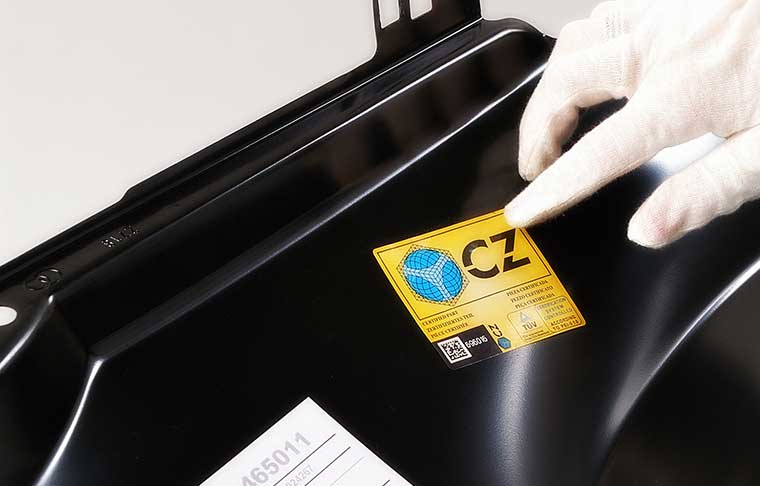
Figure 2. Equivalent Quality Spare Part that has been certified by Centro Zaragoza.
As a research institute of renown in the motor vehicle repair sector,
Centro Zaragoza has developed a certification system which enables matched quality spares of this type to be identified, which constitutes a certain guarantee for both workshops and consumers.
Spain has benefited from one of the European Union’s most liberal legislations (together with that in the UK and Italy) given that this includes a so-called “Repair Clause”, which allows alternative spares to be manufactured and used in repairs.
Centro Zaragoza’s parts certification process focuses on analysis, of both the production process followed by the manufacturer and the technical features which the part exhibits, as well as the maintenance of such conditions over time. The technical requirements for each part centre on:
- Analysis of the composition of the material used.
- The adaptability of the part to the vehicle.
- The quality of the coating and covering of the parts.
- Checking on the mechanical behaviour.
This activity has made an extensive impact across the whole of Europe where its use has spread. To date over seven million parts bear the “CZ certified part” marking.
Thus CZ certification in accordance with regulation 461/2010 and its aim of creating a more competitive market between the original spare part and those of equivalent quality has benefited consumers.
Centro Zaragoza heads up a working group of the
RCAR (1)(
Research Council for Automobile Repairs), which is an international association of motor vehicle research centres that belong to insurers that is concerned with the requirements that should be asked of parts and the working process of manufacturers so any specific part can be considered to comply with the standards that ensure that the above-mentioned technical requirements are met.
b) Certification of CZ workshops
The repairs sector represents a key component of the chain of services in motor vehicle insurance. With the intention of collaborating with workshops to improve the quality of the services provided for customers and also of boosting their productivity,
Centro Zaragoza has developed a certification system that systematically allows them to make strides towards excellence in how they are organised and in their technical competence. To guarantee transparency and objectivity for certification of this kind AENOR, the national standards body, is working with
Centro Zaragoza on this project.
Becoming a CZ certified workshop represents a strategic decision that can increase the confidence of its customers and the profitability of its activities. On the other hand it means that insurers can have a group of workshops at their disposal where the quality of their work has been verified.
Under this certification process, the following aspects are examined in relation to the workshop seeking CZ certification:
| Administrative aspects: |
Technical requirements: |
- Legal situation.
- Supervision of suppliers.
- Risk prevention plan.
- Waste management.
- Cost control.
- Training in damage appraisal.
|
- Features and fittings.
- Installation facilities.
- Work processes.
- Premises lay-out.
|
The CZ Workshop Certification System is currently an established activity which is permanently active. In other words it is not confined to certifying the workshop but also incentivises the ongoing improvement of some of them and acknowledges excellence when some of these have attained higher levels by motivating and enhancing all of their levels of organisation and this then allows there to be recognition of three, four or five star CZ certified workshops. This task of certifying workshops has also been extended to Portugal and Turkey and is undergoing a phase of expansion.
Centro Zaragoza currently does not just collaborate with workshops but also with networks which demand that their members have a set of technical requirements. The work performed in certifying workshops has also attracted the attention of various different manufacturers of certain makes of vehicles with which we work as consultants to develop programmes to help improve their efficiency levels while also increasing customer satisfaction.
c) Certification of other products
With the same goal of promoting competitive markets and helping to improve quality, we certify:
- Workshop management programmes.
- Systems for tracking down and following stolen vehicles.
- And generally equipment, tools and products for motor vehicle repairs.
2.2.2. Painting rate scales
Appraisal of painting processes is carried out by the various different motor vehicle constructors in their technical documentation. A comparative analysis of the results obtained by different manufacturers in the case of similar parts with similar damage reveals a disparity in terms of results that cannot technically be justified. For example:
Front door, replacement, two coats:
- Opel Corsa D-5p: time 3.60 hours.
- Renault CLIO III 5p: time 4.70 hours.
Both parts have a surface area of 80 dm
2 and there is a 30% difference in the time suggested for them to be repaired.
Another example:
Front wing, replacement, two coats:
- Citroën C1 2005: time 3.00 hours.
- Opel Corsa D: time 1.80 hours.
Both parts measure 35 dm
2 and yet there is a 65% difference in their suggested repair time.
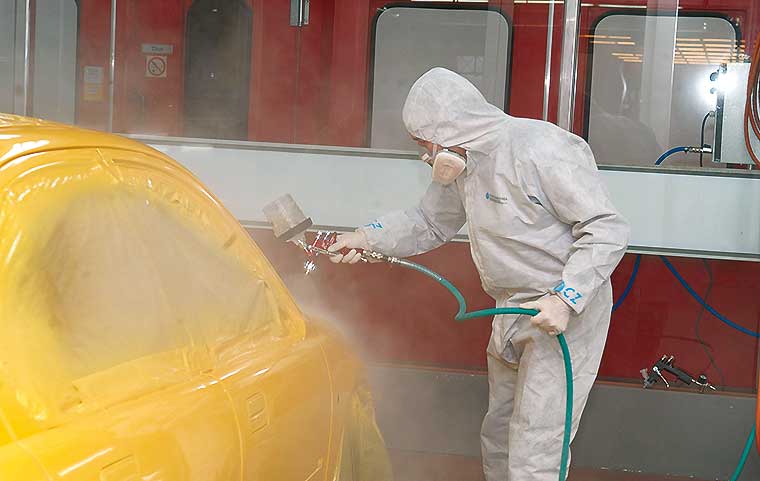
Figure 3. Process of painting a vehicle on the premises of Centro Zaragoza.
To summarise, these and many other examples meant that Centro Zaragoza came up with the idea of drawing up a painting rate scale that should be independent of the make of vehicle and based on technical criteria such as damaged surface areas, type of material, location of the part, etc. This turned out to be no easy task as it took a team of researchers more than five years. At present it still needs permanent updating for the new models of vehicles that come onto the market, as well as updating the prices which are set by manufacturers, and also the time needed to perform each repair when new painting materials or techniques emerge.
Centro Zaragoza set up a technical committee for preparing, approving and following this, which was chaired by the highest body representing the loss adjusting sector (APCAS) and where one of its members was the main association in the repairs sector.
The rate scales are therefore scientific instruments which are of high technical value and serve as a guide when damage appraisals are carried out. They should therefore be a point of contact between the repairs and adjustment sectors: an objective and conciliatory element. The CZ painting rate scale has become established as a tool that combines a high degree of precision in calculating repairs estimates with ease of use.
On the other hand, this quality of uniformity across the whole territory as regards repair times and the amount of materials to be applied is undeniably useful.
2.2.3. Vehicle Auction Management (Gestión de subasta de vehículos, GSV)
The vehicle auction management platform (GSV) is intended to sell vehicles by auction that have suffered accidents and been declared total write-offs (VFU) and those which have been stolen and recovered via the Centro Zaragoza website, to which access is restricted to authorised users.
On the one hand GSV allows authorised sellers to key in the records of vehicles that have been declared total write-offs following accidents or stolen vehicles which have been recovered so they can be sold by auction and, on the other hand, it lets authorised buyers enter offers to buy by making appropriate bids for the vehicles on offer.
2.2.4. Tracking down and recovery of stolen vehicles
Centro Zaragoza acts as a technical link (assigned for the purpose by UNESPA, the Spanish Association of Insurers) with the State law enforcement bodies (Fuerzas y Cuerpos de Seguridad del Estado) as regards the illegal trafficking of vehicles that have been stolen and compensated paid out for it by the insurance industry. Collaboration of this kind works thus:
When a vehicle is stolen and compensation paid out for this by an insurer, the latter sends its registration number to Centro Zaragoza, along with other elements identifying it. After passing through a quality control check, this information is sent to the National Police Force’s Data Centre, which in turn sends it out to the various different police stations. If the vehicle is recovered by one of these, the information on it is reported back to Centro Zaragoza which then sends it to the insurer for it to initiate the recovery process for it.
For a decade now Centro Zaragoza has had a 24 hours Technical Assistance Service (SAT in Spanish) for police notification and a Transfer and Deposit Service (STD in Spanish) for taking away vehicles which have been seized when the relevant authorities require this.
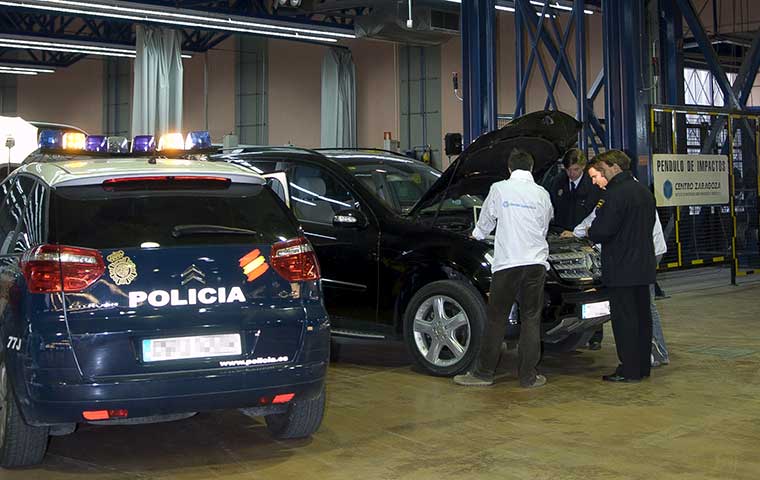
Figure 4. Staff from the section for stolen vehicles at Centro Zaragoza working together with the State law enforcement bodies on identifying a recovered vehicle.
Centro Zaragoza’s collaboration with the police forces also extends to the sphere of training. Every year courses on the illegal trafficking of vehicles are given on our premises which are attended by senior police personnel from the National Police Force, the Civil Guard, and both Regional and Local police forces. Over the course of such training they go into depth on identifying vehicles and processes for detecting counterfeiting.
Notable here is the partnership agreement signed with the General Secretariat of Interpol with regard to the illegal trafficking of vehicles to track down and recover stolen vehicles.
The “Integrated Management System for Stolen and Indemnified Vehicles” was created by
Centro Zaragoza and provides the following services for insurers:
- Locating the vehicle in Spain or abroad.
- Processing for releasing vehicles.
- Collection and transfer of the vehicle to our premises.
- Legalisation for cases of counterfeit vehicles.
- Repair of the vehicle.
2.2.5. Damageability and reparability reports
The purpose of the “damageability and reparability reports” prepared by
Centro Zaragoza is to provide our insurers with indices featuring the results for reparability of the vehicle examined in the various low speed crash-testing standardised by the RCAR (Research Council for Automobile Repairs), which enable vehicles to be classified within the segment they belong to. The vehicles are sorted into segments according to their size and functionality.
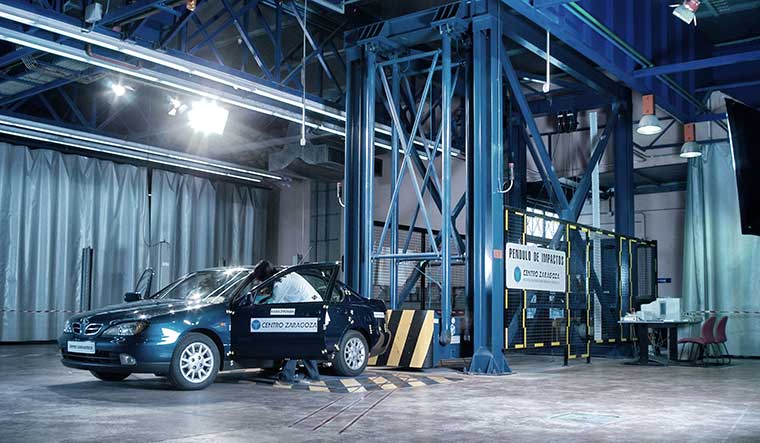
Figure 5. Preparing a crash test at the Centro Zaragoza impact pendulum
The segments defined are: Micro(MIC), Small(PEQ), Compact(COM), Medium(MED), Four-door saloon(BER), Luxury(LJO), Compact People Carrier(MNV COM), Medium People Carrier(MNV MED), SUV(TCN), Crossover(CRO), Combis(COMB), Medium Combi(COM MED), Compact 4x4(4x4 COM), Four-door saloon 4x4(4x4 BER).
The damageability and reparability reports include the results of head-on and side collisions and shunting from behind with as detailed description of the parts replaced or repaired, as well as weighting of this in the overall result. These reports can be used by the actuaries at each insurer to calculate the insurance premium for each vehicle.
2.2.6. Parts reparability studies and analyses
Centro Zaragoza conducts analysis of the methods and processes that might allow those parts to be repaired which bring down costs to the insurance industry considerably owing to the frequency of their involvement in accidents and their high cost.
Here
Centro Zaragoza examines the working methods available in the market, establishes the criteria required to assess the results obtained and supervises the profitability and quality levels obtained for the various different parts that can apply to them (headlights, window panes, plastic parts of the motor vehicle, etc.). The aim is to generate more competitive markets by identifying working methods that enable repairs to be made of proven quality, thereby offering the workshop several options to make quality repairs and cut costs to the end user.
2.2.7. Repair versus replacement studies
Centro Zaragoza has the technological know-how when it comes to vehicle repair processes and the ability to pass this on to workshops to help them contribute to their practice whenever this is technically and financially possible.
Repairing versus replacing parts on vehicles that have suffered damage offers the following advantages:
- Financial: generally, subject to prior assessment, repairing parts represents a saving compared to replacement with new parts.
Repairing helps save time out of use and produces savings with respect to needing replacement vehicles.
- Technical: with welded bodywork parts or non-retrievable joining elements following assembly, restoration to the original state is less aggressive when repairing is the chosen option.
- Arranging: time is cut in making arrangements for and receiving materials.
- Environmental: the workshop cuts costs of storing and handling waste.
- Service: tends toward a faster service for the insured.
Centro Zaragoza analyses and decides on preliminary action that needs to be taken for later definition of the technical and training action that is required in each case to put this practice into effect.
2.2.8. CZ spares platform
The CZ spares platform is conceived as a tool for communication between workshops and distributors of spares, the main objective of which is to help the vehicle repair workshop in its task of buying the spares required or repairing a damaged vehicle without restricting the workshop’s freedom to choose the spare part to use as long as this is compliant with the specifications in article 9 of Royal Decree 1457/1986.
The platform provides workshops with web access in real time in a direct, standardised, precise and reliable manner to the different spare parts needed to effect a repair and at their prices for all of the suppliers that have the spares in stock, thereby improving the efficiency of the resources used in the process by the various participants.
CZ spares (
CZ Recambios) makes it possible to optimise the costs of repairing a damaged vehicle by improving the process of buying spares and enabling access to the opportunities that stem from active management in buying and supplying spares.
The objectives of the platform are based on the following aspects:
- Promoting and facilitating transparency in buying the spare part used in a repair, as regards both the sale price and its sourcing.
- Ensuring traceability of the spare part acquired since this is identified by its make and reference.
- Offering access to various offers of the spares from the constructor and spares of verified quality from independent manufacturers.
- Promoting competitiveness in the sector by facilitating access by users and distributors to a broader market.
- Providing information that facilitates and improves carrying out the process of buying spare parts which the workshop engages in without restricting its ability to freely choose which spare to use for each repair.
CZ Recambios is based on a wholly web-driven technological tool that vertically integrates workshops, adjusters and distributors with access tailored to the functions each of these parties require, the key features of which are:
- Registration and maintenance for users (workshops, adjusters and distributors).
- Virtual storage featuring the stocks of the distributors connected to the platform with information on availability, retail price, price and net price for all kinds of spares.
- Integrated with valuation systems (Audatex, GTE, Eurotax) – extraction of the valuation and automatic updating based on the purchase order’s spares information.
- Allows integration with electronic invoicing tools (workshop-insurer).
- Tracking of the spares order’s status (requested, accepted, delivered).
- Supervision of processing times from valuation up to delivery of the material.
- Functionality for recording and maintaining incidents.
- User care service.
- Guarantees data security.
2.2.9. CZ Plus
This is an electronic invoicing system created by
Centro Zaragoza in conjunction with TIREA (
Tecnología de la Información para Entidades Aseguradoras, or Communications Technology for Insurers), whereby the workshop charges the repair invoice to the insurer simply, conveniently and swiftly.
CZ Plus serves as a “workshop-insurer” communication channel. It is a web-based environment that is capable of making an invoice in less than 30 seconds, which is automatically available for the member insurer. This allows tracking of the status of the invoice at all times by the workshop and means it can be collected against in the space of roughly one week.
The advantages this service offers are very considerable, both for insurers and workshops.
- The workshop keys in its administrative details directly into the website at: www.czplus.es
- Removes potential mistakes in the payment process (the workshop’s bank account number, for example) due to human error at the insurer.
- Cuts out administration costs (avoids having to handle paper, the fax, the telephone, e-mails.).
- Avoids invoices going missing or duplicate invoices in the collection process.
- Automates, speeds up and improves communication between the workshop and the insurer.
- The cost is very low (charged per use, i.e. for each invoice issued).
2.3. Cross-cutting activities
2.3.1.Observatory to monitor the Technological Evolution of the Automobile (OTEA CZ)
Centro Zaragoza, as an automobile research centre that belongs to the insurance industry, is dedicated to researching and disseminating knowledge with regard to any aspects that relate to motor vehicles. The need to monitor such continuous developments in the field of motor vehicles has led us to decide to set up the
Observatorio de Seguimiento de la Evolución Tecnológica del Automóvil, hereafter
OTEA CZ (the Observatory to monitor the Technological Evolution of the Automobile).
OTEA CZ is intended to conduct research into new motor vehicle technologies, the reparability of the devices that incorporate Advanced Driver Assistance Systems (ADAS) and the impact (both proven and potential) on road safety.
Its specific aims are to:
- Track and analyse the technological advances which vehicle constructors build into their models.
- Analyse the reparability of the devices which ADASs include.
- Examine calibration times.
- Compare the repair times achieved with the times which the manufacturers describe.
- Disseminate information on the work conducted by OTEA CZ.
- Generate training content.
- Produce specific publications that derive from research.
- Participate in the media to raise awareness about the various different ADASs out in the market.
- Draft informative articles.
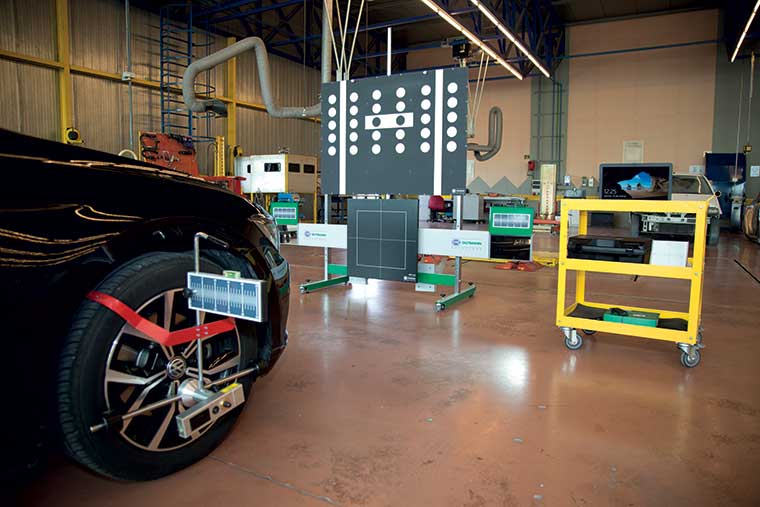
Figure 6. A vehicle with an ADAS being calibrated after being repaired on Centro Zaragoza premises.
2.3.2. Training
One of the key aims at
Centro Zaragoza, since its very beginnings and as has already been stated, has been to provide ongoing, high-quality training, for all professionals involved in the repair, loss adjustment and handling of property loss to damaged vehicles, as well as in road safety initiatives, accident investigation and, more recently professionals specialising in handling bodily injury cases.
To date
Centro Zaragoza has trained over 30,000 professionals, in both Spain and other countries with an interest in quality training.
Our catalogue consists of 40 attended courses and 15 that are on-line (via the so-called
CZ Campus), which are directed by claims handlers, motor insurance adjusters, vehicle repair workshops, accident investigators, experts from vehicle technical inspection (roadworthiness) centres and local and regional police forces, as well as the Traffic Civil Guard, among others.
Besides the extensive range of courses offered,
Centro Zaragoza makes it possible for the various different stakeholders to design tailor-made training courses and programmes to satisfy the needs of the professionals at the organisation. These training initiatives can be given either on our premises or at the facilities of the person requesting them.
Courses offered by
Centro Zaragoza:
- Road accident reconstruction:
- TD Noting data in reconstructing road accidents.
- RA1 Road accident reconstruction. Induction level.
- RA2 Road accident reconstruction. Advanced level.
- RAP Reconstruction of road accidents involving pedestrians. When people are run over.
- RAM Reconstruction of road accidents involving motorbikes.
- BLC Biomechanics of whiplash in low speed collisions.
- IVI Inspection of burned vehicles.
- DP Preparing an adjuster’s report and defending it in court.
- Road safety:
- CSE Safe and effective driving at work.
- Organising and managing a motor vehicle repair workshop:
- FOBO Front office/back office workshop management processes.
- OCT Organising and configuring a repairs workshop.
- CCT Cost control for bodywork garages.
- ECT Quality structure in a bodywork garage.
- AET Analysis and study of body-work garages.
- PFT Work processes and flows in a bodywork garage.
- GCM The mechanical workshop and cost control.
- Valuing property damage:
- PS Higher course in motor vehicle insurance adjustment.
- IP Adjustment induction course.
- VD Assessing loss regarding damaged vehicles.
- APM Adjustment work for damaged motorcycles.
- Electric and hybrid vehicles:
- VEH Electric and hybrid vehicles.
- Marketing and human resources:
- TE Teamwork.
- NEG Professional negotiator.
- GET Effective time-management.
- Repairing vehicle bodywork:
- RC Repairing immovable and fixed elements.
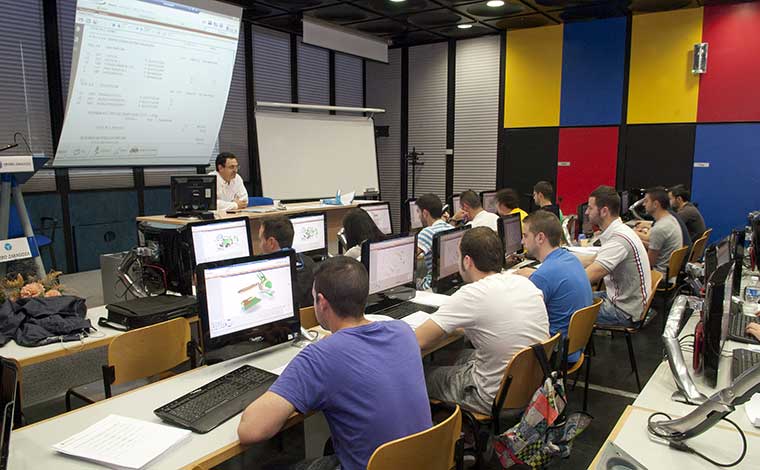
Figure 7. Staff at Centro Zaragoza giving a course on motor vehicle loss adjustment.
2.4. Services concerning the area of bodily injury
2.4.1. Road accident reconstruction
A team of engineers specialises in this work where the most cutting edge IT systems are used. Specifically the programmes PC-Crash® and Virtual Crash® are used, enabling analysis of collisions between vehicles and also their gear / speed dynamics by implementing verified physical models that are a great help in reconstructing road accidents, evaluating different hypotheses and checking on which of them are compatible with the objective data or physical evidence mentioned in police reports and which appear to be able to rule out owing to being incompatible with the documented result of the accident. Biomechanical analysis software is also used such as Madymo®, which makes it possible to calculate the subjection to forces in different directions experienced by the bodies of the occupants of the vehicles involved in the accident, as well as by cyclists, motorcyclists or pedestrians. These tools have proven highly useful and add accuracy and reliability to the analyses carried out by the engineers from
Centro Zaragoza thanks to the fact that they have highly developed technical standards as they require an in-depth knowledge of the physics behind collisions between vehicles and considerable experience in accident investigation.

Figure 8. Photogram of an accident reconstruction carried out by Centro Zaragoza.
At
Centro Zaragoza the most complex of accidents are reconstructed involving major bodily injuries or those having great social importance and some of these reconstructions are requested directly by the courts of law or sometimes by the Directorate-General for Traffic.
The experience that has been built up in over 2,000 road accident reconstruction reports prepared thusfar has made this institute one of the leading lights in this field both nationally and internationally.
The prestige earned by
Centro Zaragoza in this activity has meant that several different governments and universities internationally have required the services of
Centro Zaragoza to clarify the circumstances which have played a part in road accidents.
Centro Zaragoza has thus performed accident reconstructions in Portugal, Andorra, Ireland, Cyprus, Turkey and Chile.
2.4.2. Road safety studies
With the intention of promoting measures to help improve road safety,
Centro Zaragoza conducts various types of studies:
- On safety system efficiency.
So far more than 30 studies have been made to seek scientific evidence of the effectiveness of different safety systems, which have been requested by Traffic Authorities or professional associations. These studies have examined from the most traditional of systems such as the seat-belt, helmets, airbags, ABS braking systems, headrests, children’s safety berthings, etc. to the most advanced, such as ISAs (Intelligent Speed Adaptation systems), ACC (Adaptive Cruise Control) or CASs (Collision Avoidance Systems).
- To develop new safety technologies.
In conjunction with manufacturing companies we have helped in the development or fine-tuning and validation of innovative technologies, such as neck airbags built into helmets, protective footwear for motorcyclists, personalised lumbar protectors, active headrests, devices to keep children correctly positioned on their berthing system when they are asleep while travelling, Event Data Recorders with or without video-recording etc.
- Road safety audits. Studies for the re-designing of potentially conflictive road environments.
Centro Zaragoza’s efforts as regards these matters does not merely amount to conducting technical or scientific studies, but also, thanks to our informative capacity, this also benefits dissemination and promotes acceptance by users of all such information with the goal of stimulating demand for more effective safety systems.
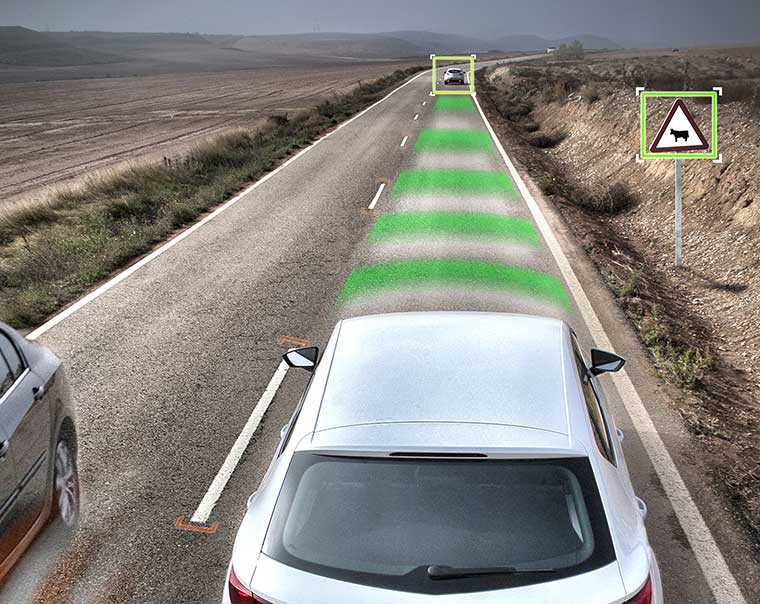
Figure 9. The Centro Zaragoza road safety activities today focus very heavily on studying the effectiveness of Advanced Driving Assistance Systems (ADASs).
2.4.3. CZ BALS (Biomechanical Analysis of Low Speed collisions)
This software application was created by Centro Zaragoza based on an algorithm for calculation developed by the group for research into Nuevas Tecnologías en Vehículos y Seguridad Vial (New Technologies for Vehicles and Road Safety, VEHI-VIAL) belonging to the Institute for Research into Engineering in Aragon (I3A), a part of the University of Zaragoza.
The aim of this software is to determine the risk of minor traumatism injury to the spine, colloquially known as whiplash, for occupants of a vehicle which has suffered a collision from being shunted. The programme takes into account various public databases of crash testing quantifying the change in speed and the acceleration experienced by the vehicle receiving the impact and also offering detailed information on the damage to the vehicles used in the testing. Centro Zaragoza periodically runs sets of controlled crash tests to verify the reliability of the algorithms used in CZ BALS to analyse this type of loss. The tool also includes an analysis of the latest accepted scientific studies which relate the violence of the collision to the risk of whiplash injury to the occupants of the vehicle that has been shunted and establish a risk of injury from the aforementioned bibliography. To analyse the forces in different directions on the spine of the occupants of the shunted vehicle, CZ BALS also analyses the NIC, or Neck Injury Criterion, which is the criterion applied to assess neck trauma suffered by the occupants of the shunted vehicle. The integrated calculation in CZ BALS is performed with the help of the Madymo® programme, which is internationally prestigious software that enables analysis of forces in different directions on the body accurately, effectively and in a versatile manner.
CZ BALS is a tool used by both insurers that wish to find out the potential risk of injury of the occupants of a vehicle in the event of a shunting collision and adjusting teams that base themselves on the results offered by CZ BALS for issuing their reports.
2.4.4. New biomechanics reports preparation service
The rising demand for expert biomechanics reports for low speed collisions has led Centro Zaragoza to extend its accident research and reconstruction service in this field , which calls for the cooperation of specialists in various different scientific and technical disciplines such as engineering and medicine. Since 2016 Centro Zaragoza has offered reports of this kind thanks to systematisation of the analytical methodology without compromising the high level of rigour and specific attention to the particular case being studied that should be a feature of any expert report.
We currently have two types of biomechanics reports: basic reports for out-of-court negotiation, and comprehensive reports that are used for submission to the law-courts.
The recent setting up of an impact track on which to analyse low speed collisions has also made it possible to broaden knowledge of low and very low force collisions by performing crash testing under controlled conditions and filming crashes and measuring speeds and acceleration levels with regard to the vehicles used. The findings from these tests are used to draw up biomechanics reports for low force collisions and also to update the CZ BALS software application.
3. Increased orientation toward preventing and managing road accident injuries
As we have been able to see,
Centro Zaragoza’s activities with respect to biomechanical analysis as this applies to preventing and managing injuries has steadily increased in recent years, reaching a major landmark in 2017 with the setting up of a department specifically devoted to examining low force collisions, although it is true that this new area of activity is based on the knowledge acquired over a long history of research into road accidents.
In 1993 the road accident research department was created. Its aim was clear, being to conduct in-depth research into the causes of accidents to help shed light on liability in them, though also to contribute to preventing such causes being repeated again, thereby helping to bring down the number of deaths and injuries on Spanish highways and in Spanish cities. It is worth remembering that in that year alone some 6,378 people had died in road accidents in Spain, which equates to over five times the current figure.
The level of precision achieved in in-depth study of accidents thanks to applying a scientific analytical method soon positioned
Centro Zaragoza as a national reference point in road accident research. Since that date it has been involved in researching over 2,000 serious accidents.
Preventing injuries in shunting-type crashes took a qualitative leap forward in the year 2000, when
Centro Zaragoza became part of the working group known as the IIWPG (International Insurance Whiplash Prevention Group), the activities of which involved carrying out testing to assess the safety levels of seating and associated headrests for new vehicles, as well as publicising the results obtained. This action had an instant effect on vehicle constructors, who upgraded the design of their seats and headrests, and in so doing came to offer far higher safety levels for vehicle occupants. Since then
Centro Zaragoza has taken part in several research projects both in Spain and on a Europe-wide basis, ranging from research into new concepts of safer and more sustainable roads to designing modular structures for light-duty electric vehicles, spearheading analysis and prevention of whiplash injuries in the project known as PRELACE (
Investigación en Tecnologías más eficaces para la Prevención del Latigazo Cervical, or “Research into more effective Technologies to Prevent Whiplash”) which led to know-how being passed on to the Spanish automotive components manufacturing industry.
In 2008
Centro Zaragoza began to study software programmes to predict the risk of whiplash injury which were being marketed in other countries, such as Italy or the UK. The various players operating in Spain needed to act fast to make the necessary estimates and, if necessary, come up with swift assistance measures for those that might be potentially injured in shunting crashes. Addressing this problem led the centre to carry out consulting work in 2011 aimed at achieving improved ways of handling accidents at low speed involving injured parties. The next step forward was the creation of the centre’s own biomechanical analysis tool for low speed collisions, the afore-mentioned CZ BALS application, using analysis of the damage to vehicles involved in an accident to calculate the severity of the crash being investigated by means of an algorithm developed by the University of Zaragoza based on over 200 controlled low speed crashes. This makes it possible to determine the likely risk of whiplash to the occupants of any vehicle being shunted from behind.
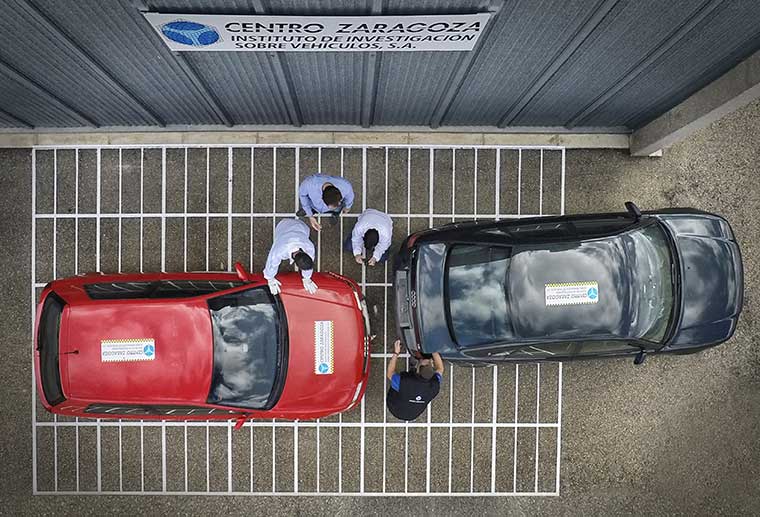
Figure 10. Setting up a crash test on Centro Zaragoza’s impact track.
In 2014 a low-speed impact track was built on the premises of
Centro Zaragoza and controlled crash testing began using vehicles which were exploited to analyse other kinds of accident beyond shunting collisions. The results obtained from the crash testing, together with the development of a rigorous and original systematic working framework, enabled the afore-mentioned collision force report service (for what are popularly known as biomechanics reports) to be launched. The flurry of activity in 2017 reflects the success attained by this working methodology, given the trust placed in it by all the organisations that request studies from
Centro Zaragoza every day. Motivation of this kind underpins our social commitment to the goal of helping to make the number of deaths and injuries on our roads tend towards zero.
(2)
The progress made by the CZ BALS application has continued in 2018 now that it has become a standard that helps towards proper handling of claims with the development of version 3.0, which is intended to enhance user experience by being more user-friendly and as regards the time needed to conclude a report, offering greater accuracy of calculations and providing greater transparency in the report produced so that the data entered by users can easily be verified by third parties. In short, this means that the values entered to obtain the results are in line with what really happened in the accident. This new version, which is due out mid-way through this year, once again shows
Centro Zaragoza’s capacity for adapting and being pro-active and anticipating demand from customers in offering effective, efficient and innovative solutions.
4. The future of Centro Zaragoza
This year of 2018 began with a new change to
Centro Zaragoza’s management following the retirement of its former manager. The fresh challenges faced by motor vehicle insurance (among other things, due to the hectic pace at which the technology is advancing which vehicles incorporate) would require a new profile that could combine considerable research experience with the capacity for business administration that managing a technology centre with a staff of 70 people needs.
The future is unpredictable but, bearing in mind the new lines of research being pursued by
Centro Zaragoza, we can expect new products and services to be produced in relation to: connected vehicles, electric vehicles, new materials used in manufacturing motor vehicles, new mobility models, Advanced Driver Assistance Systems (ADASs) and, in the longer term, driverless vehicles.
Below are details of the subjects in relation to which new lines of research are being opened up by
Centro Zaragoza and the reasons why they have been chosen for strategic reasons:
a) Connected vehicles
The report on the 17th edition of the Global Automotive Executive Survey by KPMG
(3) made it evident that connectivity and digitalisation are the most significant trends in the automotive industry and are set to remain so up to 2025. According to the report, technology and the data that a vehicle generates while being used will be a disruptive element that will build loyalty in the relationships customers have with makes of motor vehicles, as well as with insurers via the information obtained from their telematic devices installed in the motor vehicle, which will help to determine the insured’s profile as a driver. Insurers can also find out where its insured parties are located when they seek assistance, so it will be possible to provide them with help on the road or direct them to nearby workshops in a more efficient manner.
b) Electric vehicles
The introduction of electric vehicles, which is still only marginal, will soon be boosted by the reduction of battery prices and this will help them become more established as a genuinely cost-effective alternative to buying petrol and diesel driven vehicles. According to research by
Bloomberg New Energy Finance (4) in the decade of the 2020s electric vehicles will become a more economical option than petrol or diesel cars. In most countries this factor will be decisive for the electric vehicle to really take off. The study forecasts that electric vehicle sales will reach a worldwide level of 41 million in 2040, which is 35% of new sales of light vehicles.
c) New materials
In the quest for lighter materials
(5), future motor vehicle structures will be manufactured using materials that require specialist know-how and tools.
Centro Zaragoza has therefore started to look into the reparability of composite materials, aluminium alloys and other light metals, the use of which is expected to make up ground on steel, which is still the most used material.
d) Changes in mobility preferences
In the major capitals the car-sharing model has already begun to become established
(6), as has renting cars for short spaces of time (normally about one hour). This model is attractive to those wishing to use a vehicle only occasionally. The organisation of car-sharing can be handled by a company or by a group of users who form an association. Today there are more than 600 cities worldwide where people can use such services.
Another kind of company offers its users a private transport network via their mobile software app, connecting passengers to drivers of vehicles registered with their service and providing a transport service for private individuals. These companies organise pick-ups in dozens of cities around the world.
There are also shared vehicle services for inter-city journeys that allow people who want to travel to the same place and at the same time to arrange to travel together. This makes it possible to share any travel expenses (fuel and tolls) and also to avoid excess greenhouse gas emission as it means there is greater energy efficiency per vehicle used.
e) New Advanced Driver Assistance Systems (ADASs)
Every year some 1.3 million people die
(7) across the world in road accidents and in around 90% of such cases the accident is attributable to human error. The advanced driver assistance systems will help reduce human error considerably, in both risky situations and monotonous or stressful circumstances, such as parking manoeuvres. The ADAS systems currently in widespread use are:
- Automatic Emergency Braking (AEB) systems
The efficiency of these systems has been verified by EuroNCAP after studying a sample of real-life accidents where a 38% reduction in shunting accidents was observed among vehicles equipped with an AEB system (8) compared to another sample of equivalent vehicles not equipped with such systems. This data corroborates the findings of previous studies conducted by IIHS, Folksam, Thatcham, Centro Zaragoza, GDV as well as others.
Likewise, dynamic testing shows that the effectiveness of AEB systems is not the same for all vehicles, for which reason it would be of great use to the sector to subject new vehicles to testing for the purpose of classifying their safety systems according to how efficient they are. The data on accident rates for some vehicles that have built-in inter-city AEB systems (which function even at highway speeds) exhibit reductions in the frequency of accidents that feature bodily injury, essentially due to shunting happening less often, which are far higher than for those vehicles with urban AEB systems (that activate up to speeds of around 30 km/h).
- Pedestrian detection systems
These are systems that are added via software updates for automatic emergency braking systems (AEBs) based on image analysis using stereo cameras. They can avoid a large number of cases of people being run over, which is one of the types of accident that has the most potential for causing injury and their presence is notably on the rise in developed countries, especially as other road accidents are decreasing.
- Cyclist detection systems
Similar to the above, they have components in common with AEBs and only require additional software development. At the moment there are already several vehicles in the market that include such systems, which, in testing, present reliable behaviour.
- Automatic parking systems
Already very widely used, they can also greatly influence accidents that involve material damage. In the UK, this type of parking collision represents 23% of total accidents and of these, 71% happen when driving in reverse gear (9) Several research centres who are members of the RCAR are developing a test to try out these systems to guarantee that all manufacturers offer at least minimum benefits and to be able to classify the efficiency of systems out in the market.
- Lane keep systems (Lateral Drift Warning/Lane Keep Assist systems)
These are systems that are becoming increasingly widespread and which can avoid the most frequent accidents on our roads. In countries such as the UK vehicles drifting out of lane without any involvement of other people accounts for 21% of accidents. In Spain this kind of accident is the most common, representing 40% of all road accidents according to data from the DGT’s Statistics Yearbook (10).
Nowadays most of the most basic ADAS systems rely on mono or stereo cameras located at the top of the windscreen glass. The more sophisticated systems also use expensive long range radars that are placed at the front of the vehicle, in other words in an area that is highly exposed and easily damageable, even in low force collisions. According to data on accidents in Spain the window pane is affected in 10% of them. In such cases around 40% of the time the option of repairing the damage is chosen, but on 60% of occasions people choose to replace the windscreen pane. Therefore, right now and even more so in the immediate future, such a usual job as replacing a windscreen will see its cost notably increased owing to the interaction of camera-based systems located on it.
Centro Zaragoza has begun to look into the methodology for repairing and then calibrating these ADASs with the mission of making best practices more widespread in the repairs sector, as well as collaborating with vehicle manufacturers so that efficient design and repair processes are implemented, as regards both safety and costs.
f) Driverless vehicles
According to different socio-economic and technological analyses the expectation is that before 2020 the first highly autonomous vehicles may start to appear in the market from makes such as Mercedes, Tesla, Volvo, BMW and others, i.e. vehicles that (in certain environments such as motorways) will not require any interaction from a driver.
The advantages expected of autonomous driving are several:
- Less congestion.
- Better use of infrastructures (less investment needed).
- Greater productivity (due to less time travelling).
- Less pollutant emission.
- Greater safety and therefore fewer accidents on roadways.
Current forecasts regarding highly autonomous vehicles
(11)(12), in Europe’s most advanced countries and in the United States, assume that they will steadily increase in terms of new vehicle sales up to almost 70% by around 2030. By then, sales of fully driverless vehicles will have begun and in ten years (by around 2040) these will account for almost all new vehicle sales. In the following 10 to 15 years, towards 2050, virtually all of the mobile vehicle fleet will already comprise autonomous vehicles in most countries. Recent events demonstrate the difficulty of implementing these technologies and call for prudence as regards the timeframes envisaged.
Regardless of the timeframes within which such technological changes can be applied in a significant way, as a research centre serving the Spanish insurance industry,
Centro Zaragoza will be prepared to provide its companies, the government and society with any expert advice on automotive technology that they might require at any given time.










